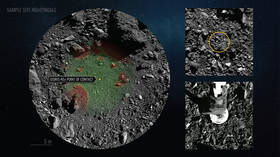Greedy grabber: NASA scrambles to return jam-packed asteroid sampler to Earth as rock dust escapes from ship’s overstuffed ‘belly’

NASA is rushing to make a 200 million mile trek back to Earth after an asteroid-sampling spacecraft bit off more than it could chew, unable to contain an oversized haul of alien rubble as its priceless cargo escapes into space.
Three days after touching down on asteroid Bennu hundreds of millions of miles away from home, NASA said its Osiris-Rex spacecraft had become so engorged with asteroid fragments that debris is now leaking from its storage compartment.
“We’re almost a victim of our own success here,” said Dante Lauretta, lead scientist on the mission, NASA’s first-ever attempt to mine a sample from the surface of an asteroid.
Today at 5pm ET: @Dr_ThomasZ of #NASAScience & @OSIRISREx principal investigator Dante Lauretta provide an update to discuss what they know about the sample collected during the spacecraft's TAG (Touch-and-Go) attempt on Tues., Oct. 20. More: https://t.co/uzhWBEvAj8pic.twitter.com/ORoswuE2UM
— NASA (@NASA) October 23, 2020
The Osiris-Rex craft – short for the “Origins, Spectral Interpretation, Resource Identification, Security-Regolith Explorer” – made contact with the small alien world on Tuesday, landing on Bennu for only a few seconds as it blasted a charge of pressurized nitrogen, disturbing surface rocks that were then collected for a sample. But the ship’s eyes were apparently too big for its stomach, taking on more material than it could handle and potentially jeopardizing the $800-million-plus mission.
Good news: on Oct. 20, our @OSIRISREx spacecraft captured more than enough material from asteroid Bennu to meet mission requirements! The team is now focused on stowing the sample for return to Earth in 2023: https://t.co/4etvnJzXfn#ToBennuAndBackpic.twitter.com/ILUzEJZHD8
— NASA (@NASA) October 23, 2020
With asteroid dust floating away from the ship and a vast journey still ahead of it, the chief of NASA’s science missions, Thomas Zurbuchen, said that “time is of the essence,” but noted that an overabundant sample is “not a bad problem to have,” provided the material does not escape at a faster rate as the craft inches closer to home.
Also on rt.com ‘Exciting new discovery about the Moon’ is coming that will impact NASA’s upcoming lunar missionWhile NASA warned that any movement of Osiris-Rex may lead to “further sample loss,” the agency said its team will now focus on storing the remaining rubble in a “sample return capsule,” where “any loose material will be kept safe during the spacecraft’s journey back to Earth.”
“I think we’re going to have to wait until we get home to know precisely how much we have,” Lauretta said at a press conference. “As you can imagine, that’s hard ... But the good news is we see a lot of material.”
Though the mishap risks being a costly one for the mission, netizens couldn’t help but relate with the ravenous asteroid-eater, comparing its binge on space rocks to a buffet outing.
Sounds like the last time I hit the buffet at Golden Corral.
— Area Man (@boyinthebarrel) October 23, 2020
— Mark Bradford (@markbrad) October 23, 2020
Same, little spacecraft, same.
— Jed Oliver (@Jed_Oliver) October 23, 2020
Others took up a more finger-wagging tone, chastising the spacecraft for its “greed” and gluttony, which one user deemed a “metaphor for the human race.”
We sent a greedy grabber to space. If there was ever a metaphor for the human race today, that might be it.
— Dilligaf 🇿🇦 (@dilligaf1024) October 23, 2020
greed doesn't work?
— MichaelCW≈≈ (@Michaelinvoid) October 23, 2020
Great, our citizens and our spacecraft are obese. 🛰️
— KeithKLongmire (@k_longmire) October 23, 2020
Osiris-Rex is set to depart the region around Bennu in March and is expected to return back to Earth sometime in 2023, seven years after the craft blasted off from its launch site in Cape Canaveral, Florida.
Like this story? Share it with a friend!














